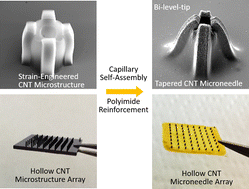Hollow microneedle array fabrication using a rational design to prevent skin clogging in transdermal drug delivery†
Abstract
Microneedle (MN) technology is promising to replace hypodermic needles for practical use and painless drug delivery. However, the complex top-down fabrication process of functional MN arrays is a bottleneck that hinders their widespread use. Here, we fabricate the tapered hollow MN array using a unique bi-level-tip by combining strain-engineering and capillary self-assembly of carbon nanotube (CNT) microstructures. Strain-engineering facilitated by the offset pattern of the catalyst enables the growth of bent, bi-level CNT microstructures while capillary self-assembly helps in constituting the tapered geometry of MNs. The bottom-up fabrication that consists of only two standard photolithography steps and CNT growth to form the scaffold of MNs followed by a polymer (polyimide) reinforcement step to impart mechanical stiffness to MNs provides scalable and fewer processing steps. The tapered shape of the MN allows an 8 times smaller force to pierce and penetrate the skin compared to the straight MN. The liquid delivery rate of the bi-level-tip MN is measured to be 26% better than the flat tip MN of the same lumen size as its geometry reduces skin clogging effect at the needle tip. In addition, cytotoxicity tests verify that the polyimide reinforced CNT-MNs are biocompatible for future in vivo applications.

- This article is part of the themed collection: Microneedles


 Please wait while we load your content...
Please wait while we load your content...